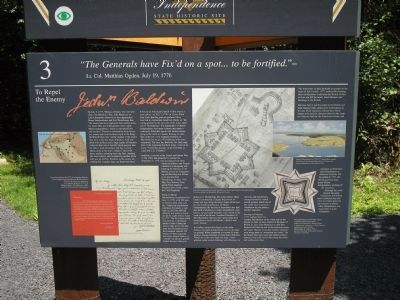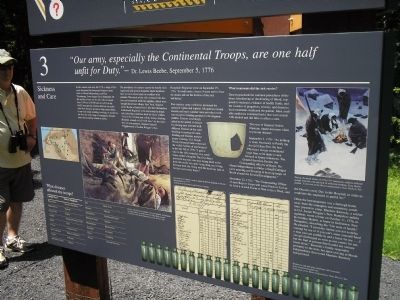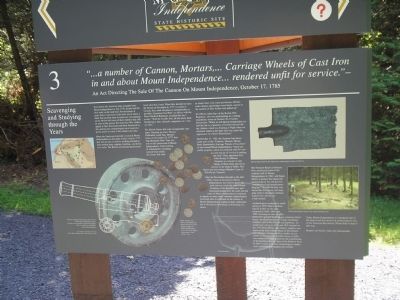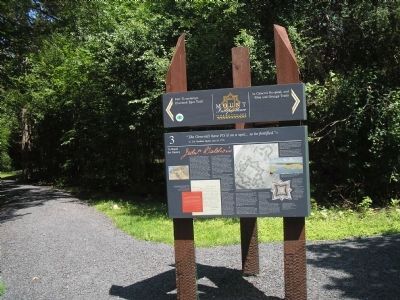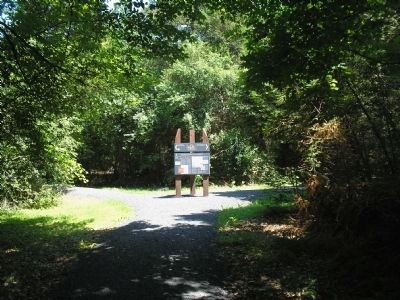Orwell in Addison County, Vermont — The American Northeast (New England)
To Repel the Enemy
“The Generals have Fix’d on a spot . . . to be fortified.” -
Lt. Col. Matthias Ogden, July 19, 1776
On July 5, 1777, Thomas Anburey, who was traveling with British Lt. Gen. John Burgoyne on Lake Champlain, observed as they approached Mount Independence and Fort Ticonderoga that “the Americans have employed their utmost industry where they are in the greatest force, upon Mount Independence, which is extremely lofty and circular.” Thanks to information from deserters, scouts, and local residents loyal to the King, the British knew that “on the summit of the mount they have a star fort made of pickets, well supplied with artillery, and a large square of barracks within it; that side of the hill which projects into the lake is well intrenched, and has a strong abates close to the water, which is lined with heavy artillery pointing down the lake, flanking the water battery, and sustained by another about half way up the hill. Fortified as the enemy are, nothing but a rectangular siege can dispossess them.”
It was at an American Council of War nearly a year earlier – on July 7, 1776 – at Crown Point, New York, that the generals gathered there resolved to concentrate American efforts on “the strong ground on the east side of the Lake, opposite to Ticonderoga.” The topography of Mount Independence had many features that made it extremely defensible against the British enemy lying to the north in Canada. Wasting no time, they ordered Lt. Col. Jeduthan Baldwin of Massachusetts to go to Ticonderoga with some carpenters. The next day Baldwin, the chief engineer of the American Northern Army, wrote in his diary: “Viewd the grounds on the East Side ye Lake with Col. Trumball.”
Baldwin, a veteran of the French and Indian War (1756 – 1763) and promoted to colonel on September 3, 1776, had assistance from other American officers and French volunteers in designing and building the defenses at the Mount, as well as strengthening and building new defenses at and near Fort Ticonderoga. In May 1777 Maj. Gen. Horatio Gates asked Polish engineer Thaddeus Kosciusko to help the Chief Engineer.
Work on Mount Independence commenced on July 11, 1776, with 200 men to “Clear a road, Dig well, &c.” American construction continued for nearly a year, right up until the difficult decision was made to evacuate on the night of July 5 and 6, 1777. The first major effort was erecting a substantial artillery battery along the water’s edge across the lake from Fort Ticonderoga and the Grenadier redoubt. On August 16 they began the horseshoe-shaped battery or “citadel” on elevated ground behind the new battery to protect it if Ticonderoga fell to the enemy. Other soldiers constructed a lengthy breastwork of stones and logs along the rocky slopes of the eastern and southern perimeters of Mount Independence. By the end of September they had also built a laboratory to make ammunition, storehouses, several small hospitals, and a wharf at the south end of the Mount. Jonathan Blanchard of New Hampshire observed that “great pains have been taken to fortify this Mount, which is now pretty Strong.”
In October construction began on the main defense, the eight-pointed picket fort on the highest ground. When completed it covered 4.5 acres with an outside perimeter of more than 1,600 feet. Within the walls were eight one-story, wood-planked, gable-roofed buildings with chimneys for barracks and storehouses, arranged around a central parade ground. Inside one of the points they excavated a foundation for the primary powder magazine.
Starting in February 1777, soldiers built two wooden blockhouses on the south side of the Mount. In June, as news arrived of the plans of British Lt. Gen. John Burgoyne to split New England off from the rest of the American states, Dr. James Thacher wrote that “utmost exertions” were made to “strengthen our works.” On the Mount three new stone and earthen cannon batteries were
built in late June along the south and southeastern lines.
The Americans, as they hurriedly evacuated on the night of July 5 and 6, 1777, realized that burning their fortifications would alert the British of their actions and left the nearly intact defenses and buildings to the British.
Between July 6 and November 8, the British and their German allies added more fortifications to the site. Their engineers ordered three blockhouses to be built in close proximity to the southern batteries built by Americans in June, and had plans to build three more blockhouses in unknown locations. On November 8, 1777, the British garrison abandoned Mount Independence, torching all the structures.
Although the wood burned, the many foundations left behind have weathered time and serve as witness posts for the moment in history when independence was being built on Lake Champlain.
Second Marker:
Sickness and Care
“Our army, especially the Continental Troops, are one half unfit for Duty.”
- Dr. Lewis Beebe, September 5, 1776
In late summer and early fall 1776, a range of diseases decimated the American Northern Army ranks at Mount Independence and Fort Ticonderoga. From August 24 to September 29, the number of men on the sick rolls increased from 1,878 out of 9,949 men to 4,072 of the 10,825 men present. Doctors
did not yet understand how diseases spread or what caused them, so survival meant avoiding, resisting, or recuperating from the wide range of contagious diseases more than avoiding wounds in battle.
The prevalence of sickness caused the hastily built regimental and general hospitals (their locations have yet to be discovered) to overflow with patients. The needs of the sick overtaxed the doctors and exhausted medicine supplies, which were brought here from Albany, New York. Surgeon Lewis Beebe of Enoch Poor’s 8th New Hampshire Continental Regiment even distrusted the hospitals, believing conditions hard for those soldiers “sick to be crowded into a dirty, Lousy, stinking Hospital, enough to kill well men.” As the numbers of sick mounted, Surgeon Samuel Wigglesworth of Joshua Wingate’s New Hampshire Regiment wrote on September 27, 1776, “It would make a heart of stone melt to hear the moans and see the distress of the sick and dying.”
Poor sanitary camp conditions increased the spread of typhus and typhoid. Mosquitoes carried malaria and heavy rains provided excellent mosquito breeding grounds in the stagnant puddles. Doctors unwittingly added to the spread of disease by placing men infected with different illnesses in the same building or reusing the same bedding and blankets without proper cleaning. Col. Joseph Wood of Pennsylvania
witnessed the visible horrors of one hospital in the late fall of 1776. “I paid a visit to the sick yesterday, in a small house called a hospital. The first object presented my eyes, one man lying dead at the door, the inside two more lying dead, two living between them; the living with the dead has laid so far four and twenty hours.”
What treatments did the sick receive?
Doctors practiced the common procedures of the times: bloodletting or the drawing of blood, supposed to maintain a balance of bodily fluids, and the issuance of purgatives, emetics, and diuretics. Such treatments weakened the patient. Most available medicines contained herbs that were mixed with alcohol and did little to affect a cure.
Two sets of General Orders illustrate simple measures taken to prevent disease:
September 3, 1776 – “As nothing is more Necessary to Purify the Are [air] than Fire, the best Physicians always recommend large fires to be made in new Ground or Damp Situations. The General therefore Desires the Commanding officers of Regts. On Mount Independence to Order a Small fat[i]gue party morning and Evening to burn up heaps of Brush around Several Encampments.”
December 22, 1776 – “The Commanding Officer of each Regt or Corps will cause Pitch or Tarr to be burn’d in each Room or Tent twice a Week, and the Doctors every Day in the Hospital, in order to evaporate the stagnated or putrid Air.”
Often the best treatment was a furlough home away from the contagion and unsanitary conditions present in camp. Matthew Kennedy, a soldier in Col. Josiah Wingate’s New Hampshire militia regiment, wrote a letter on October 11, 1776, to his brother, Robert, at home in Goffstown, New Hampshire, describing his “low state of health.” He pleaded, “I earnestly intreat you not to delay coming for me or if you can’t come yourself Send a man you can confide in and a horse for me . . . I can get discharged as soon as one comes for me; but I am frail at present that I could not venture home alone.” Kennedy’s family responded promptly to the note, but upon arriving at Mount Independence discovered Matthew Kennedy had perished.
Colonial Term --- Modern Diagnosis
Bloody Flex --- Amoebic Dysentery
Bibulous Fever --- Typhoid
Camp Fever --- Typhus
Carrarh --- Allergies / Common Cold
Cholic --- Colic
Coeyza --- Common Cold
Fever and argue --- Influenza / Malaria
Grippe --- Influenza
Intermittent Fever --- Malaria
Itch --- Body Lice
Measles --- Measles
Putrid Fever --- Diphtheria / Typhus
Remittent Fever --- Malaria
Rheumatism --- Rheumatism
Smallpox --- Smallpox
Tussis --- Coughing
Worms --- Internal Parasites
Third Marker:
Scavenging and Studying through the Years
“ . . . a number of Cannon, Mortars, . . . Carriage Wheels of Cast Iron in and about Mount Independence . . . rendered unfit for service.” -
An Act Directing The Sale Of The Cannon On Mount Independence, October 17, 1785
Even before the American army straggled onto Mount Independence in July 1776, people had left their mark on the land here. For thousands of years Native Americans made tools out of chert, a black, fine-grained stone in numerous outcroppings on the Mount and traces of their industry may still be seen on the ground. Revolutionary War soldiers appear to have discovered and been fascinated by this ancient past; archaeologists have found projectile points in some of the soldier’s hut sites.
When the Americans hurriedly evacuated Mount Independence on the night of July 5 and 6, 1777, they had no time to destroy anything and had to leave behind many supplies, buildings, and defensive works. The British and German garrison utilized what they found. When they decided to leave the Mount on November 8, 1777, to return to Canada, they made the place as uninhabitable as possible. Lieutenant Von Hille, an officer with the Prinz Friedrich Regiment, recorded the day’s events, “With the reveille shot, all the newly built blockhouses, huts, barracks, magazines etc. were set afire.”
The British flames left some recognizable remnants, Vermont governor Thomas Chittenden wrote Gen. Horatio Gates on November 22, 1777, that Maj. Benjamin Wait “who was sent to take possession of Mount Independence, found nothing of consequence, excepting several boats which the enemy had sunk, in which there were some provisions. All barracks, houses and bridges were burnt, cannon to the number of fifty broken and spiked up.”
In 1780 Lt. John Enys of the British 29th Regiment, who was participating in a raiding expedition, wrote on October 30 of further destruction. “When we left Mount Independence we had Set fire to a Quantity of brushwood and old dry Abbatis which was burning at Night when we returned, which in the Dark had very much the appearance of a Great Illumination.”
On October 17, 1785, the Vermont legislature made note of the “Cannons, Mortars, Mortar Beds, Bombshells, Carriage Wheels of Cast Iron” in and around Mount Independence “which are public property, which are rendered unfit for service and may be of service in making bar iron.” They appointed Col. John Strong of Addison, Vermont, as a trustee to take charge of these items and sell at auction to the highest bidder. The buyer was iron monger Matthew Lyon of Fair Haven, Vermont.
After the Revolution through to the mid-1900s, much of the land on Mount Independence was used to graze animals and was relatively undeveloped. Evidence of the Revolutionary past fascinated people over the years and the name of Mount Independence continued to appear on many maps. Amateur archaeologists excavated sites or collected on the surface at Mount Independence, adding to their collections but in the process disturbing or destroying evidence.
The Vermont Board of Historic Sites purchased much of the southern half of Mount Independence in 1961, and began efforts to protect this important archaeological site and prevent “unauthorized and promiscuous diggings.” In 1965-66 they conducted the first survey and mapping work to document archaeological sites and lay out a trail system.
Archaeologists conducted a small survey in 1975. Major archaeological studies on the land occurred in 1989, 1990 and 1992, focusing on sites around the picket fort, general hospital, one American blockhouse, the Southern battery, a large storehouse complex, and two brigade encampments. An underwater survey in 1992 and 1993 focused on the 1777 Great Bridge and military supplies scattered on the lake bottom. Many of the artifacts and scholarly findings of these studies are on exhibit in the museum. Another survey in 2001 was conducted in preparation for the construction of the Southern Battery Spur of the Baldwin Trail. In 2003 results of all land archaeological studies were systematically mapped and verified.
Today Mount Independence is considered one of the largest and best preserved archaeological sites of the American Revolution. Please help us keep it that way.
Respect our history. Take only photographs.
Erected by Mount Independence State Historic Site.
Topics. This historical marker is listed in this topic list: War, US Revolutionary. A significant historical month for this entry is February 1777.
Location. 43° 49.495′ N, 73° 22.916′ W. Marker is in Orwell, Vermont, in Addison County. Marker can be reached from Mount Independence Road, on the right when traveling south. Marker is along the walking trail in Mount Independence State Historic Site. Touch for map. Marker is in this post office area: Orwell VT 05760, United States of America. Touch for directions.
Other nearby markers. At least 8 other markers are within walking distance of this marker. General Hospital – 1777 (within shouting distance of this marker); Burial Site (about 500 feet away, measured in a direct line); Third Brigade Encampment – 1776 (about 600 feet away); Heritage Travelers over the Years (about 600 feet away); Storehouse - 1776 (about 800 feet away); Lake Champlain and the American Revolution (approx. 0.2 miles away); British Blockhouse - 1777 (approx. 0.2 miles away); Foundation -1776 or 1777 (approx. 0.2 miles away). Touch for a list and map of all markers in Orwell.
More about this marker. On the first marker: The top right of the marker features a painting of Mount Independence in 1776-1777 from the Collection of the Mount Independence Coalition and Mount Independence State Historic Site. Next to this is an image from the powder horn of John Calfe showing the picket or star fort and citadel or horseshoe battery, from the Collection of the New Hampshire Historical Society.
On the second marker: A picture of sick soldiers at Mount Independence is at the top of the marker. It has a caption of “During 1776 disease ran rampant, care was remedial, and hospitals were poor places in which to recover. Greg Harlin painter, Collection of the Mount Independence State Historic Site,” Another painting by Harlin is at the marker’s upper right corner, with the caption, “During the harsh winter of 1776-1777 American soldiers suffered greatly from the cold and lack of sufficient clothing.” Also on the marker is an “Itemized list of supplies used to equip the British hospital on Mount Independence in 1777, from the Collection of the Library and Archives Canada, and a picture of Stoneware cup and glass medicine vials excavated at the General Hospital Site, from the Collection of the Mount Independence State Historic Site.
On the third marker: A photograph taken during the 1990 archaeological study of the General Hospital area appears on the right side of the marker. Photos of a shovel, a carriage wheel and various coins excavated on Mount Independence also appear on the marker.
Related markers. Click here for a list of markers that are related to this marker. This series of markers are found on the walking trails in Mount Independence State Historic Site.
Credits. This page was last revised on November 3, 2020. It was originally submitted on May 30, 2009, by Bill Coughlin of Woodland Park, New Jersey. This page has been viewed 1,746 times since then and 20 times this year. Photos: 1, 2, 3, 4, 5. submitted on May 30, 2009, by Bill Coughlin of Woodland Park, New Jersey.
